By Leen Randell
Updated: Jul 10, 2024
10 Best Herbal Decoctions For Aging
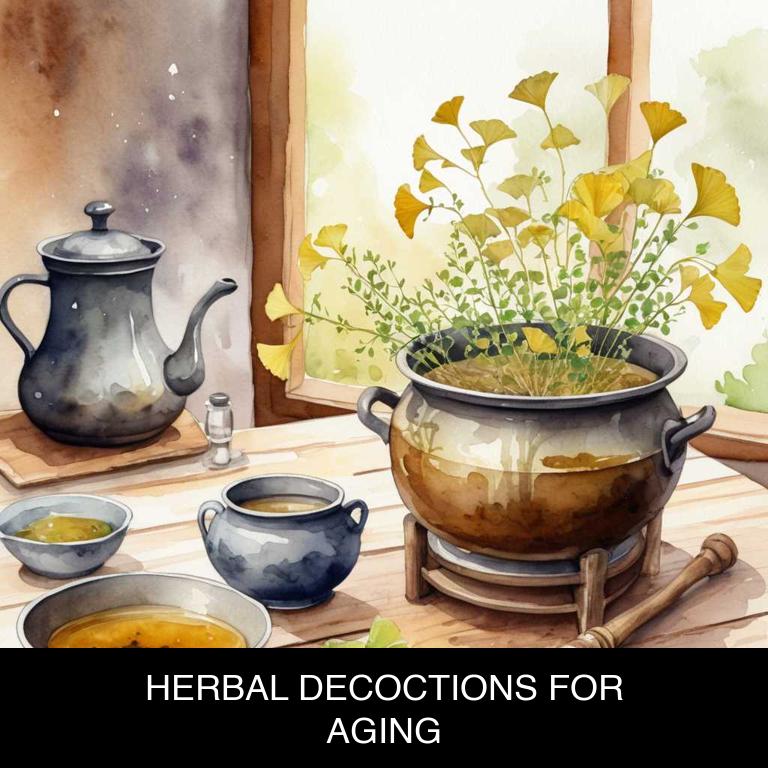
Herbal decoctions for aging are concentrated liquid extracts made by steeping herbs in hot water, which can help combat the visible signs of aging.
These decoctions work wonders by promoting collagen production, reducing inflammation, and improving skin elasticity, leaving users with a more youthful appearance. Examples include turmeric decoction, rich in antioxidants that combat free radicals, and ginseng decoction, known to improve circulation and reduce fine lines.
By incorporating these herbal remedies into their daily routine, individuals can expect improved skin health, increased energy levels, and a sense of renewed vitality, allowing them to live life to the fullest.
The following article describes in detail the most important decoctions for aging, including medicinal properties, parts of herbs to use, and recipes for preparations.
- 1. Ginkgo biloba
- 2. Withania somnifera
- 3. Curcuma longa
- 4. Panax ginseng
- 5. Camellia sinensis
- 6. Crataegus monogyna
- 7. Glycyrrhiza glabra
- 8. Sambucus nigra
- 9. Taraxacum officinale
- 10. Calendula officinalis
- What is the best combination of herbal decoctions to use for aging?
- What ailments similar to aging are treated with herbal decoctions?
1. Ginkgo biloba
Maidenhair tree decoctions helps with aging because they contain a rich source of antioxidants, such as flavonoids and phenolic acids.
These compounds help to neutralize free radicals that accumulate in the body over time, causing oxidative stress and inflammation. By reducing this damage, maidenhair tree decoctions may help to promote healthy skin, hair, and nails, while also supporting the immune system and overall well-being.
Additionally, they are believed to have anti-aging properties that can help to reduce wrinkles and fine lines, resulting in a more youthful appearance.

Medicinal Constituents
The list below shows the primary medicinal constituents in Ginkgo biloba decoctions that help with aging.
- Flavonoids: These antioxidants help protect cells from oxidative stress and damage caused by free radicals, contributing to the prevention of age-related diseases such as Alzheimer's and age-related macular degeneration.
- Bilobalide: As a neuroprotective agent, bilobalide helps maintain healthy neuronal function and promotes cognitive function, which can decline with age, thereby supporting memory and learning abilities.
- Ginkgolides: These diterpene lactones have anti-inflammatory and antioxidant properties, which can help reduce age-related inflammation and oxidative stress in the body, thereby promoting overall health and well-being.
Parts Used
The list below shows the primary parts of maidenhair tree used to make decoctions for aging.
- Leaves: These are the most commonly used part due to their high concentration of flavonoids and terpenoids, which are believed to contribute to the plant's anti-aging and cognitive benefits.
- Seeds: Ginkgo seeds have been traditionally used to promote blood circulation and memory, potentially counteracting age-related cognitive decline.
- Roots: Ginkgo roots are also used in decoctions for their purported anti-inflammatory and antioxidant properties, which may help alleviate age-related health issues.
Quick Recipe
The following recipe gives a procedure to make a basic maidenhair tree for aging.
- Harvest 30-60 grams of dried ginkgo biloba leaves from a reputable source with high quality control.
- Rinse the dried leaves with filtered water to remove impurities and debris from processing.
- Combine the rinsed ginkgo biloba leaves with 1 liter of cold water in a large pot.
- Simmer the mixture over low heat for 30-60 minutes to release active compounds.
- Strain the decoction through a cheesecloth or fine mesh into a clean container.
2. Withania somnifera
Ashwagandha decoctions helps with aging because it promotes cellular regeneration, reducing visible signs of wrinkles and fine lines.
The herb's adaptogenic properties help mitigate stress-induced oxidative damage, preserving skin elasticity and firmness. Additionally, ashwagandha's antioxidant and anti-inflammatory compounds may slow down the degradation of collagen and elastin, maintaining youthful-looking skin.
By supporting the body's natural defense against free radicals, ashwagandha decoctions can help counteract the visible effects of aging, leaving skin looking radiant and rejuvenated.
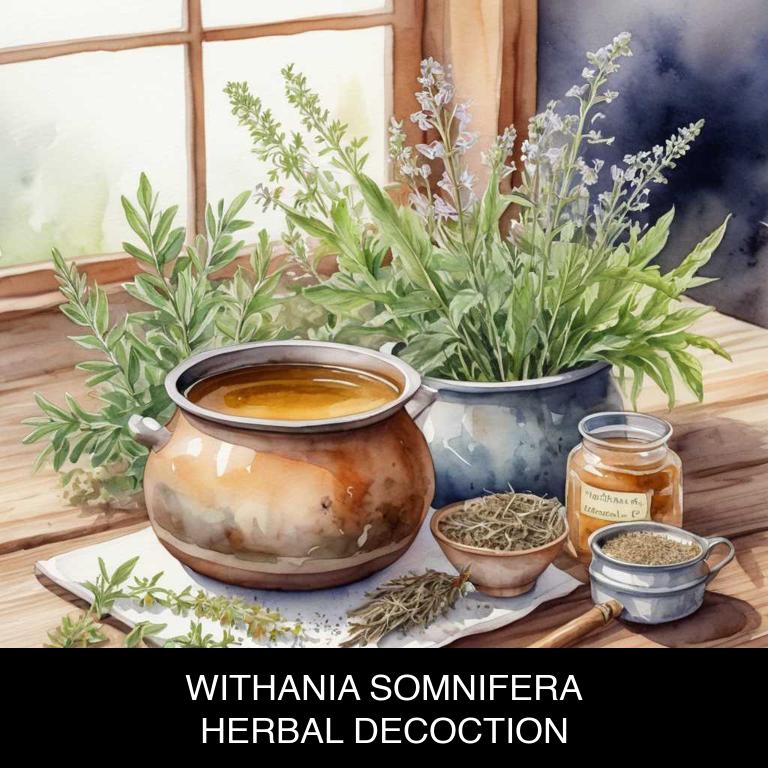
Medicinal Constituents
The list below shows the primary medicinal constituents in Withania somnifera decoctions that help with aging.
- Withanolides: Withanolides, a group of steroidal lactones, have been shown to have antioxidant and anti-inflammatory properties that help mitigate oxidative stress and inflammation associated with aging.
- Withaferin a: Withaferin A, an alkaloid constituent of Withania somnifera, has been found to have anti-aging effects by promoting autophagy, a process that helps remove damaged cellular components and maintain cellular homeostasis.
- Withanoside iv: Withanoside IV, a glycoside constituent of Withania somnifera, has been demonstrated to have anti-oxidative and anti-inflammatory properties, which may help protect against age-related diseases such as neurodegeneration and cardiovascular disease.
Parts Used
The list below shows the primary parts of ashwagandha used to make decoctions for aging.
- Roots: The roots of Withania somnifera are the most commonly used part for making decoctions due to their high concentration of bioactive compounds.
- Leaves: The leaves are used due to their adaptogenic properties, which help the body adapt to stress and promote overall well-being.
- Seeds: The seeds are used in decoctions as they are believed to enhance the effects of Withania somnifera on cognitive function and memory.
Quick Recipe
The following recipe gives a procedure to make a basic ashwagandha for aging.
- Harvest fresh roots of withania somnifera for decoction preparation by digging them up during the monsoon season.
- Clean the roots thoroughly by washing them in cold water to remove dirt and debris.
- Chop the cleaned roots into small pieces using a sharp knife to increase their surface area.
- Boil one teaspoon of chopped roots in two cups of water for 15-20 minutes to extract the active compounds.
- Strain the decoction and discard the solids to obtain a ready-to-use liquid extract for consumption.
3. Curcuma longa
Turmeric decoctions helps with aging because of its potent antioxidant and anti-inflammatory properties.
The curcuminoids present in turmeric have been shown to reduce oxidative stress, which is a major contributor to cellular damage and premature aging. By reducing inflammation and oxidative stress, turmeric decoctions can help alleviate age-related symptoms such as joint pain, skin discoloration, and cognitive decline.
Additionally, its antioxidant properties help protect against environmental stressors that can accelerate the aging process, promoting overall health and well-being.
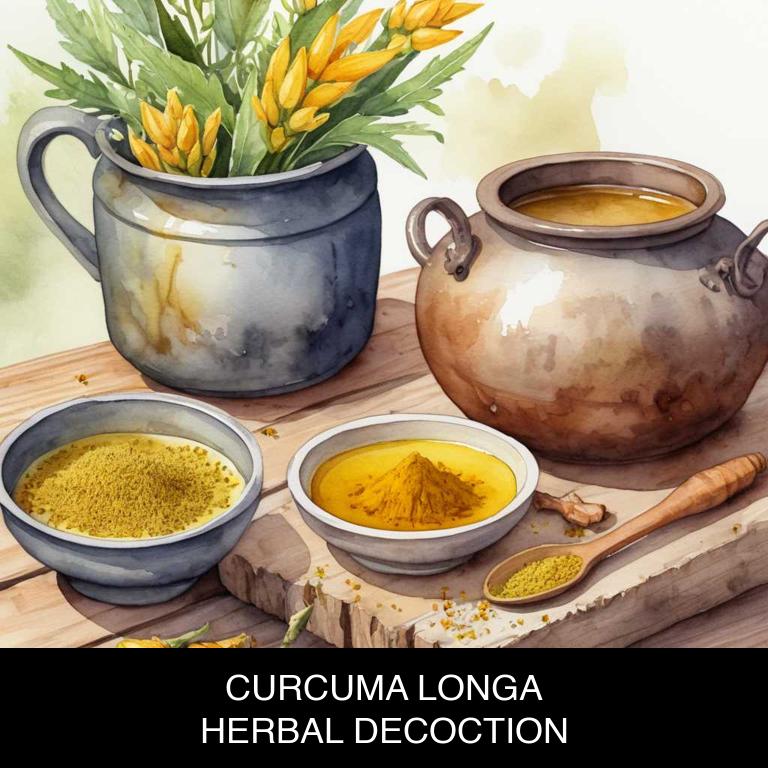
Medicinal Constituents
The list below shows the primary medicinal constituents in Curcuma longa decoctions that help with aging.
- Curcumin: Curcumin is a polyphenolic compound that helps with aging by reducing oxidative stress and inflammation, which are associated with the aging process.
- Demethoxycurcumin: DMC, a demethoxylated derivative of curcumin, has antioxidant and anti-inflammatory properties that help mitigate cellular damage and promote healthy aging.
- Volatile oil component - turmerone: Turmerone, an essential oil component of turmeric, has anti-inflammatory and neuroprotective effects that help protect against age-related neurodegenerative diseases and promote overall cognitive function.
Parts Used
The list below shows the primary parts of turmeric used to make decoctions for aging.
- Rhyzomes: Rhyzomes are the primary part used for decoctions related to aging because they contain a high concentration of curcumin, a compound with anti-inflammatory and antioxidant properties.
- Roots: Roots are also used for decoctions related to aging due to their ability to promote healthy skin and reduce oxidative stress.
- Leaves: Leaves are sometimes used for decoctions related to aging as they are believed to have anti-inflammatory and antioxidant properties that can help alleviate symptoms of aging.
Quick Recipe
The following recipe gives a procedure to make a basic turmeric for aging.
- Harvest 20-30 grams of dried curcuma longa rhizomes from a reputable supplier or grow your own.
- Dry the rhizomes in a low-temperature oven at 150°f for 2 hours to remove excess moisture.
- Grind the dried rhizomes into a fine powder using a spice grinder or mortar and pestle.
- Combine 1 teaspoon of the powder with 1 liter of boiling water in a saucepan to create a decoction.
- Reduce heat to a simmer and let it steep for 10-15 minutes before straining and discarding solids.
4. Panax ginseng
Ginseng decoctions helps with aging because it contains adaptogenic compounds that promote overall vitality and resilience.
As we age, our bodies naturally produce less energy and experience decreased physical function. Ginseng decoctions stimulate the production of ATP, increasing energy levels and enhancing mental clarity. Additionally, ginseng's antioxidant properties help to mitigate oxidative stress, reducing inflammation and cell damage that can contribute to signs of aging such as wrinkles and age spots.
By promoting a sense of well-being and vitality, ginseng decoctions may help individuals feel younger and more energetic despite the passing years.
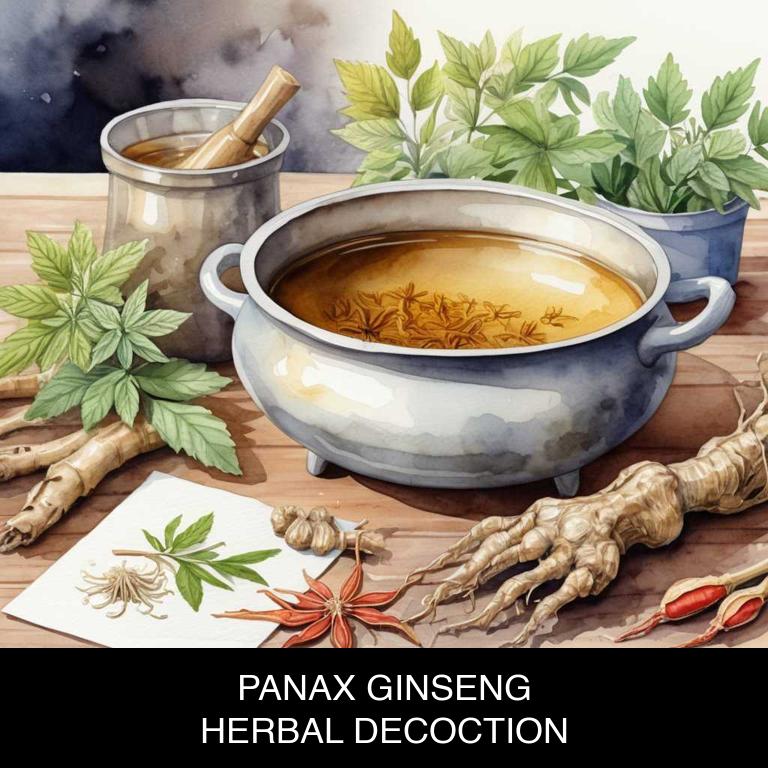
Medicinal Constituents
The list below shows the primary medicinal constituents in Panax ginseng decoctions that help with aging.
- Ginsenosides: These triterpenoid saponins in Panax ginseng have been found to promote anti-aging by enhancing cellular energy metabolism, reducing oxidative stress, and improving mitochondrial function, ultimately contributing to healthier aging.
- Glycosides: The glycosides present in Panax ginseng, particularly the ginsenosides, have been shown to possess anti-inflammatory properties, which can help mitigate the negative effects of chronic inflammation associated with aging and age-related diseases.
- Polyphenols: The polyphenolic compounds in Panax ginseng have antioxidant and free radical-scavenging activities, which can neutralize oxidative stress and promote the maintenance of cellular homeostasis, thereby supporting healthy aging and potentially delaying age-related diseases.
Parts Used
The list below shows the primary parts of ginseng used to make decoctions for aging.
- Roots: Roots are the most used part of Panax ginseng because they are rich in ginsenosides, the primary bioactive compounds responsible for the plant's medicinal properties.
- Roots: Roots are also the primary source of the plant's adaptogenic properties, which help to reduce stress and promote vitality.
- Roots: The roots of Panax ginseng are used to make decoctions that are believed to improve cognitive function and memory, particularly in traditional Asian medicine.
Quick Recipe
The following recipe gives a procedure to make a basic ginseng for aging.
- Harvest 4 to 12 pounds of dried panax ginseng roots from sustainable sources.
- Grind the roots into coarse powder using a spice grinder or mortar.
- Combine 1 to 2 teaspoons of the powder with 4 cups of water in a saucepan.
- Bring the mixture to a boil over high heat then reduce to a simmer for 1 to 2 hours.
- Strain the decoction through a cheesecloth or fine-mesh sieve into a clean container.
5. Camellia sinensis
Tea decoctions helps with aging because they offer a natural way to combat the signs of aging, such as wrinkles, fine lines, and age spots.
The antioxidants and phytochemicals present in herbal teas like green tea, chamomile, and rosehip work synergistically to reduce oxidative stress, promote collagen production, and improve skin elasticity, giving the skin a smoother and more youthful appearance.
Additionally, these decoctions can help to boost energy levels, support mental clarity, and promote overall well-being, which is essential for maintaining a healthy and vibrant lifestyle as we age.
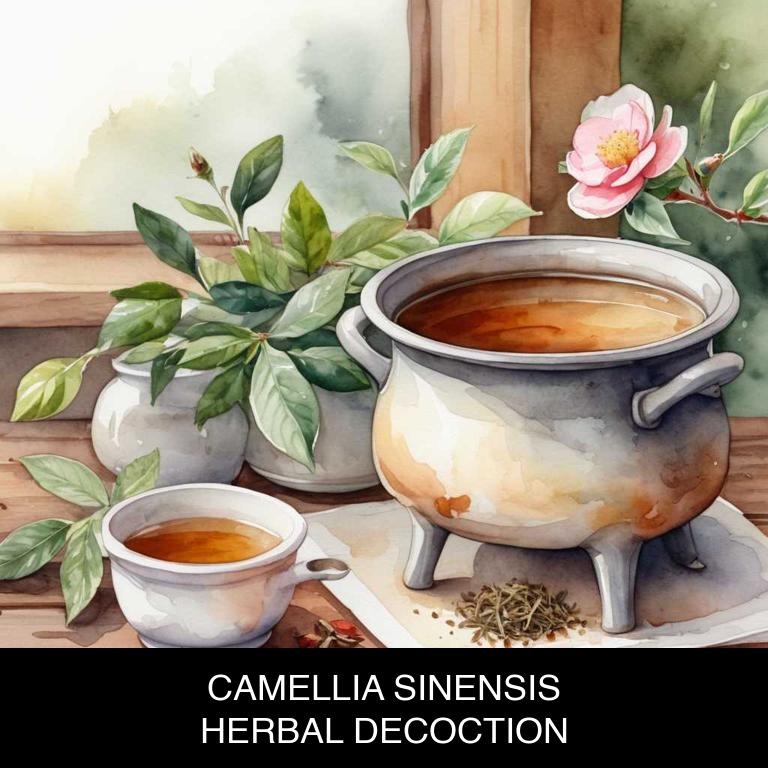
Medicinal Constituents
The list below shows the primary medicinal constituents in Camellia sinensis decoctions that help with aging.
- Catechins: These polyphenolic compounds help reduce oxidative stress and inflammation associated with aging, thereby protecting cells and tissues from damage.
- Theaflavins: These flavonoid compounds have potent antioxidant and anti-inflammatory properties, which help mitigate age-related cellular and tissue damage, and promote overall health and well-being.
- Epigallocatechin gallate: As a powerful antioxidant and anti-inflammatory agent, EGCG helps protect against age-related diseases such as cancer, cardiovascular disease, and neurodegenerative disorders by reducing oxidative stress and inflammation.
Parts Used
The list below shows the primary parts of tea used to make decoctions for aging.
- Roots: Used for its adaptogenic properties to promote vitality and reduce stress.
- Leaves: Used for its antioxidant and anti-inflammatory properties to promote overall well-being and longevity.
- Buds: Used for its anti-aging and rejuvenating properties to improve skin health and reduce fine lines.
Quick Recipe
The following recipe gives a procedure to make a basic tea for aging.
- Harvest 10 to 20 fresh camellia sinensis leaves of suitable quality for decoction.
- Cleanse the leaves by rinsing them gently with cold water to remove impurities.
- Chop the leaves into small pieces to increase their surface area for extraction.
- Steep 1 teaspoon of the chopped leaves in 1 cup of boiling water for 5 to 7 minutes.
- Strain the decoction using a fine-mesh sieve or cheesecloth to remove the solids.
6. Crataegus monogyna
Hawthorn decoctions helps with aging because of its remarkable antioxidant and anti-inflammatory properties.
The flavonoids, anthocyanins, and quercetin present in hawthorn help to combat oxidative stress and inflammation that can damage cells and tissues over time. This leads to a reduction in signs of premature aging such as wrinkles, age spots, and sagging skin.
Additionally, hawthorn's ability to improve blood flow and lower blood pressure helps to prevent cardiovascular diseases that are common among older adults, promoting overall health and well-being during the aging process.
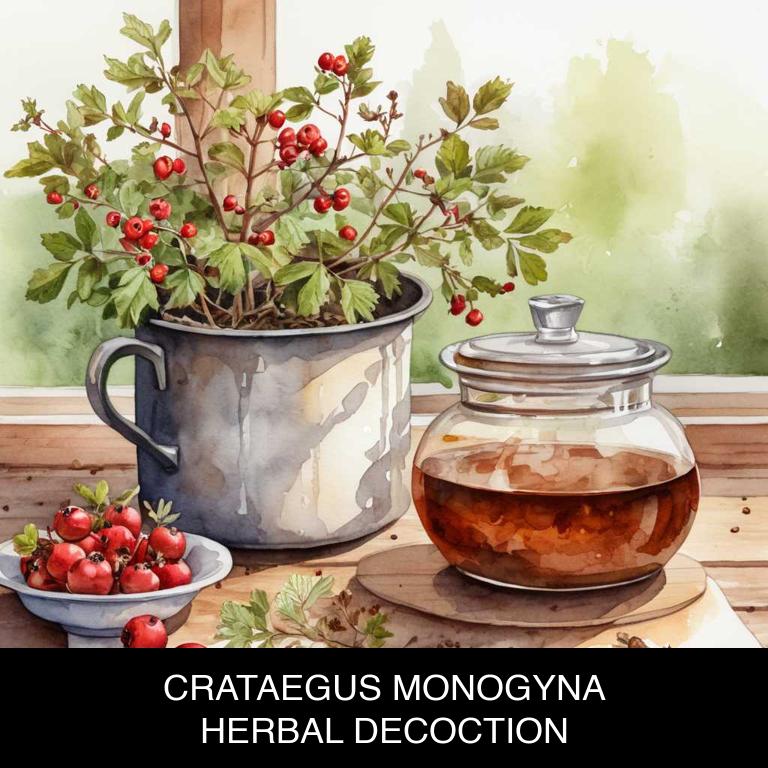
Medicinal Constituents
The list below shows the primary medicinal constituents in Crataegus monogyna decoctions that help with aging.
- Flavonoids: Flavonoids, particularly quercetin and kaempferol, help with aging by protecting against oxidative stress and inflammation, which are known to contribute to the progression of age-related diseases.
- Phenolic acids: Phenolic acids, such as chlorogenic acid and caffeic acid, help with aging by exerting antioxidant and anti-inflammatory effects, which can help mitigate the damage caused by free radicals and promote overall health and well-being.
- Triterpenoids: Triterpenoids, including ursolic acid and oleanolic acid, help with aging by inhibiting pro-inflammatory pathways and promoting cellular health, which can help reduce the risk of age-related diseases such as cardiovascular disease and cancer.
Parts Used
The list below shows the primary parts of hawthorn used to make decoctions for aging.
- Flowers: They are used for their astringent and antiseptic properties, believed to help reduce wrinkles and improve skin elasticity.
- Fruits: They are used for their antioxidant and anti-inflammatory properties, which are thought to help slow down the aging process and promote overall health.
- Buds: They are used for their astringent and anti-inflammatory properties, which are believed to help reduce inflammation and promote tissue repair.
Quick Recipe
The following recipe gives a procedure to make a basic hawthorn for aging.
- Harvest 1-2 kilograms of fresh leaves and twigs of crataegus monogyna in the summer or early fall season.
- Dry the harvested plant material in a well-ventilated area at 40-50 degrees celsius for 2-3 days.
- Grind 20-30 grams of dried crataegus monogyna into a fine powder using a mortar and pestle.
- Steep 1-2 teaspoons of the powdered plant material in 250 milliliters of boiling water for 10-15 minutes.
- Strain the decoction through a cheesecloth or a fine-mesh sieve to remove the plant material.
7. Glycyrrhiza glabra
Licorice decoctions helps with aging because it is rich in antioxidants, flavonoids, and glycosides that work together to combat oxidative stress and inflammation.
These compounds have been shown to improve skin elasticity, reduce wrinkles, and even out skin tone. Additionally, the anti-inflammatory properties of licorice help to alleviate joint pain and stiffness associated with aging, promoting flexibility and mobility.
By nourishing and protecting the skin and joints, licorice decoctions can help individuals look and feel younger, more vibrant, and healthier as they age.

Medicinal Constituents
The list below shows the primary medicinal constituents in Glycyrrhiza glabra decoctions that help with aging.
- Glycyrrhizin: Helps with aging by reducing inflammation and oxidative stress, which are associated with cellular aging and age-related diseases.
- Licochalcone a: Helps with aging by inhibiting the activity of advanced glycosylation end-products (AGEs), which accumulate with age and contribute to oxidative stress and inflammation.
- Isoliquiritigenin: Helps with aging by promoting the activity of anti-aging enzymes, such as SIRT1, and reducing the activity of pro-aging enzymes, which contribute to cellular aging and age-related diseases.
Parts Used
The list below shows the primary parts of licorice used to make decoctions for aging.
- Roots: Used for decoctions as they contain glycyrrhizin, a compound that can help to reduce stress and promote overall well-being.
- Roots: Also used due to their adaptogenic properties, which may help to alleviate symptoms of aging such as fatigue and joint pain.
- Roots: Additionally, roots are used for their potential anti-inflammatory effects, which may help to reduce the risk of age-related diseases.
Quick Recipe
The following recipe gives a procedure to make a basic licorice for aging.
- Gather 20-30 grams of dried glycyrrhiza glabra roots and rinse them under cold running water.
- Chop the roots into small pieces to increase their surface area for infusion.
- Combine the chopped roots with 2 liters of distilled water in a large saucepan.
- Bring the mixture to a boil over high heat and then reduce the heat to a simmer.
- Allow the mixture to steep for 15-30 minutes before straining and serving.
8. Sambucus nigra
Elder decoctions helps with aging because they contain antioxidants, flavonoids, and other bioactive compounds that have been shown to combat the signs of aging.
These compounds help to reduce oxidative stress, inflammation, and cellular damage caused by free radicals, which can contribute to wrinkles, age spots, and premature decline.
Regular consumption of elder decoctions may also improve skin elasticity, boost collagen production, and enhance overall skin health, resulting in a more youthful appearance.
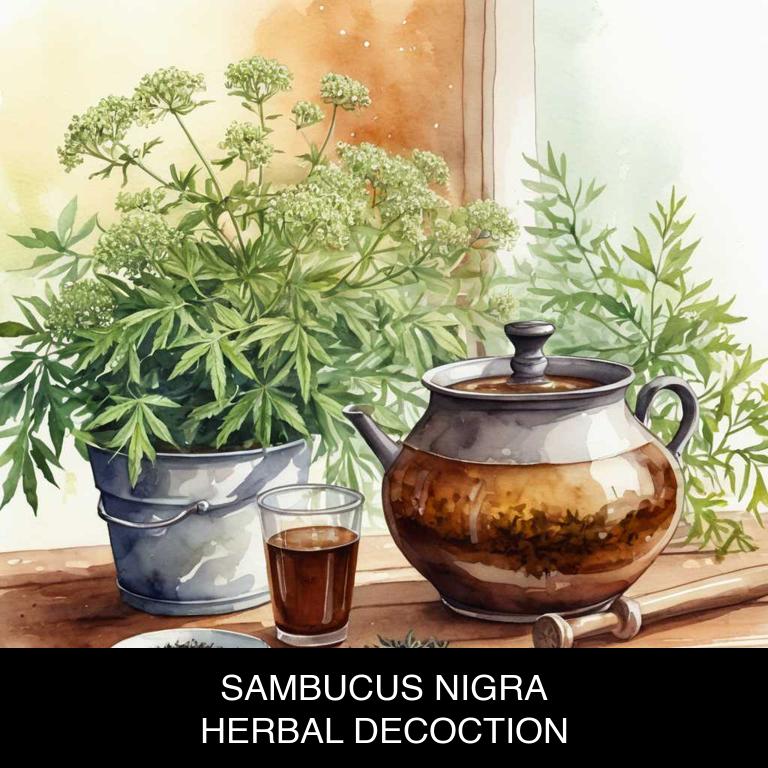
Medicinal Constituents
The list below shows the primary medicinal constituents in Sambucus nigra decoctions that help with aging.
- Flavonoids: These plant-derived compounds have antioxidant properties, which can help mitigate oxidative stress and inflammation associated with aging, potentially contributing to healthier skin, hair, and overall well-being.
- Ellagic acid: A polyphenolic compound found in Sambucus nigra, ellagic acid has been shown to possess anti-inflammatory and antioxidant properties, which may help protect against age-related diseases such as neurodegeneration and cardiovascular disease.
- Quercetin: A flavonoid with potent antioxidant activity, quercetin can help neutralize free radicals and reduce inflammation, potentially contributing to healthier aging by protecting against age-related diseases such as osteoarthritis and cognitive decline.
Parts Used
The list below shows the primary parts of elder used to make decoctions for aging.
- Flowers: Sambucus nigra flowers are often used to make decoctions that promote relaxation, reduce stress, and alleviate symptoms of menopause due to their high content of flavonoids and other bioactive compounds.
- Barks: Sambucus nigra barks are sometimes used to make decoctions that support cardiovascular health and may help alleviate symptoms of aging, such as reduced blood flow and increased blood pressure.
- Leaves: Sambucus nigra leaves are occasionally used to make decoctions that have anti-inflammatory and antioxidant properties, which may help alleviate symptoms of aging, such as joint pain and reduced cognitive function.
Quick Recipe
The following recipe gives a procedure to make a basic elder for aging.
- Gather 1-2 tablespoons of dried sambucus nigra flowers and 1 cup of boiling water for decoction preparation.
- Combine the dried flowers with boiling water in a heat-resistant container and let steep for 10 minutes.
- Strain the mixture through a cheesecloth or a fine-mesh sieve into a clean container to remove solids.
- Allow the decoction to cool to room temperature or refrigerate it for later use as needed.
- Store the sambucus nigra decoction in the refrigerator for up to 3 days in airtight glass containers.
9. Taraxacum officinale
Dandelion decoctions helps with aging because it is rich in antioxidants, vitamins, and minerals that support overall health.
The plant's bioactive compounds, such as flavonoids and phenolic acids, have been shown to combat free radicals and oxidative stress, which contribute to the signs of aging like wrinkles, age spots, and fine lines.
Additionally, dandelion decoctions may help reduce inflammation, improve digestion, and support liver function, all of which can contribute to a more radiant and youthful appearance as we age.

Medicinal Constituents
The list below shows the primary medicinal constituents in Taraxacum officinale decoctions that help with aging.
- Phenolic acids: These compounds help reduce oxidative stress and inflammation, which contribute to aging by protecting cells from damage and promoting overall cellular health.
- Flavonoids: Flavonoids in dandelion decoctions have antioxidant and anti-inflammatory properties, which can help mitigate age-related diseases by reducing the risk of chronic diseases, such as cardiovascular disease and cancer.
- Polysaccharides: Polysaccharides in dandelion decoctions may stimulate the immune system, promoting cellular renewal and regeneration, which can help maintain youthful vitality and reduce the visible signs of aging.
Parts Used
The list below shows the primary parts of dandelion used to make decoctions for aging.
- Roots: Roots are used due to their high content of saponins and other compounds believed to have anti-inflammatory and antioxidant effects, which may help mitigate age-related diseases.
- Leaves: Leaves are used due to their high content of flavonoids and other bioactive compounds, which may help protect against oxidative stress and cell damage associated with aging.
- Seeds: Seeds are used due to their high content of saponins and other compounds, which may have anti-inflammatory and antioxidant effects, and may help support bone health, a concern for many older adults.
Quick Recipe
The following recipe gives a procedure to make a basic dandelion for aging.
- Gather 30-60 grams of taraxacum officinale roots and rhizomes for decoction preparation.
- Rinse the roots and rhizomes under cold running water for 2-3 minutes to remove debris.
- Combine the roots and rhizomes with 1 liter of water in a medium-sized saucepan.
- Bring the mixture to a boil over high heat then reduce the heat to medium-low for 10-15 minutes.
- Strain the decoction through a cheesecloth or fine-mesh sieve into a clean container.
10. Calendula officinalis
Pot marigold decoctions helps with aging because they contain potent antioxidants and flavonoids that combat free radicals and inflammation, two primary contributors to premature aging.
The decoctions also possess anti-glycation properties, which help prevent the damage caused by advanced glycosylation end-products (AGEs) that can lead to wrinkles and age spots.
Additionally, pot marigold's anti-inflammatory compounds may help reduce the appearance of fine lines and wrinkles, leaving skin looking smoother and more youthful.

Medicinal Constituents
The list below shows the primary medicinal constituents in Calendula officinalis decoctions that help with aging.
- Triterpenoids: These compounds in Calendula help reduce inflammation and oxidative stress, which are key factors in the aging process and can contribute to age-related diseases.
- Flavonoids: As powerful antioxidants, flavonoids in Calendula help protect cells from damage caused by free radicals, promoting healthy aging and reducing the risk of age-related diseases.
- Sesquiterpenes: These compounds have been shown to have anti-inflammatory and antioxidant properties, which can help mitigate the effects of aging on skin and other tissues.
Parts Used
The list below shows the primary parts of pot marigold used to make decoctions for aging.
- Flowers: They are the most commonly used part due to their high content of antioxidants and anti-inflammatory compounds, which can help combat the signs of aging.
- Leaves: The leaves contain flavonoids and phenolic acids, which have been shown to have antioxidant and anti-aging effects, making them a popular choice for decoctions.
- Roots: The roots of Calendula officinalis are also used, as they contain sesquiterpenes and triterpenes, which have anti-inflammatory and antioxidant properties that can help mitigate the effects of aging.
Quick Recipe
The following recipe gives a procedure to make a basic pot marigold for aging.
- Harvest calendula flowers at peak bloom to ensure potency and quality of the herbal decoction.
- Dry the flowers in a warm dark place for 1-2 weeks to preserve their medicinal properties.
- Measure 1 tablespoon of dried flowers per 8 ounces of water to create a strong decoction.
- Steep the flowers in boiling water for 5-7 minutes to release their active compounds.
- Strain the liquid and discard the solids to obtain a clear and potent herbal decoction.
What is the best combination of herbal decoctions to use for aging?
The best combination of herbal decoctions that help with aging is a blend of Reishi, Ashwagandha, and Ginseng.
Reishi mushroom reduces inflammation and promotes cellular regeneration, while Ashwagandha enhances vitality and stress resilience. Ginseng improves circulation, boosts energy, and supports immune function. This synergistic combination helps to mitigate the effects of aging, such as declining energy and cognitive function.
It also promotes overall well-being, flexibility, and a sense of calm, making it an effective herbal remedy for promoting healthy aging.
What ailments similar to aging are treated with herbal decoctions?
Ailments similar to aging/decoctions.html">aging/decoctions.html">aging that are treated with herbal decoctions are degenerative conditions such as osteoarthritis, gout, and rheumatoid arthritis.
These decoctions, often made from anti-inflammatory herbs like turmeric, ginger, and devil's claw, help reduce joint pain and inflammation, improving mobility and flexibility.
Additionally, they may also be used to treat cardiovascular issues, such as high blood pressure, and metabolic disorders, including diabetes and obesity.